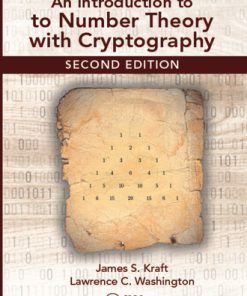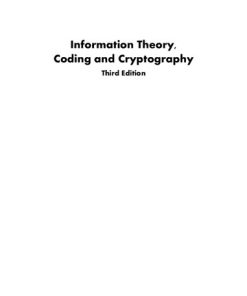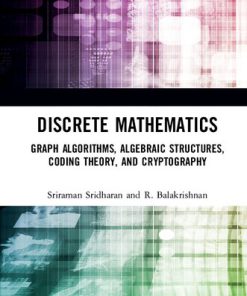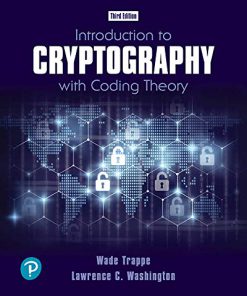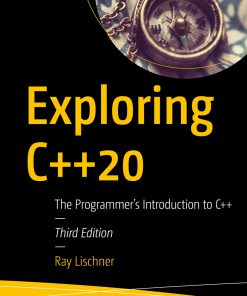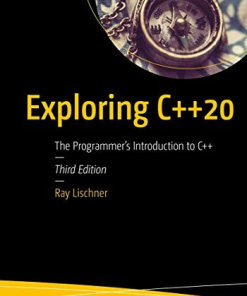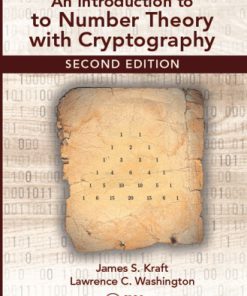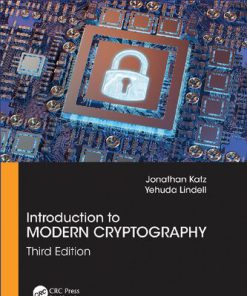Introduction to Cryptography with Coding Theory 3rd Edition by Lawrence Washington, Wade Trappe ISBN 0134860985 9780134860985
$50.00 Original price was: $50.00.$25.00Current price is: $25.00.
Introduction to Cryptography with Coding Theory 3rd Edition by Lawrence C. Washington, Wade Trappe – Ebook PDF Instant Download/Delivery: 0134860985, 978-0134860985
Full dowload Introduction to Cryptography with Coding Theory 3rd Edition after payment

Product details:
ISBN 10: 0134860985
ISBN 13: 978-0134860985
Author: Lawrence C. Washington, Wade Trappe
Introduction to Cryptography with Coding Theory 3rd Table of contents:
Chapter 1 Overview of Cryptography and Its Applications
1.1 Secure Communications
1.1.1 Possible Attacks
1.1.2 Symmetric and Public Key Algorithms
1.1.3 Key Length
1.2 Cryptographic Applications
Chapter 2 Classical Cryptosystems
2.1 Shift Ciphers
2.2 Affine Ciphers
2.3 The Vigenère Cipher
2.3.1 Finding the Key Length
2.3.2 Finding the Key: First Method
2.3.3 Finding the Key: Second Method
2.4 Substitution Ciphers
2.5 Sherlock Holmes
2.6 The Playfair and ADFGX Ciphers
2.7 Enigma
2.8 Exercises
2.9 Computer Problems
Chapter 3 Basic Number Theory
3.1 Basic Notions
3.1.1 Divisibility
3.1.2 Prime Numbers
3.1.3 Greatest Common Divisor
3.2 The Extended Euclidean Algorithm
3.3 Congruences
3.3.1 Division
3.3.2 Working with Fractions
3.4 The Chinese Remainder Theorem
3.5 Modular Exponentiation
3.6 Fermat’s Theorem and Euler’s Theorem
3.6.1 Three-Pass Protocol
3.7 Primitive Roots
3.8 Inverting Matrices Mod n
3.9 Square Roots Mod n
3.10 Legendre and Jacobi Symbols
3.11 Finite Fields
3.11.1 Division
3.11.2 GF(2^8)
3.11.3 LFSR Sequences
3.12 Continued Fractions
3.13 Exercises
3.14 Computer Problems
Chapter 4 The One-Time Pad
4.1 Binary Numbers and ASCII
4.2 One-Time Pads
4.3 Multiple Use of a One-Time Pad
4.4 Perfect Secrecy of the One-Time Pad
4.5 Indistinguishability and Security
4.6 Exercises
Chapter 5 Stream Ciphers
5.1 Pseudorandom Bit Generation
5.2 Linear Feedback Shift Register Sequences
5.3 RC4
5.4 Exercises
5.5 Computer Problems
Chapter 6 Block Ciphers
6.1 Block Ciphers
6.2 Hill Ciphers
6.3 Modes of Operation
6.3.1 Electronic Codebook (ECB)
6.3.2 Cipher Block Chaining (CBC)
6.3.3 Cipher Feedback (CFB)
6.3.4 Output Feedback (OFB)
6.3.5 Counter (CTR)
6.4 Multiple Encryption
6.5 Meet-in-the-Middle Attacks
6.6 Exercises
6.7 Computer Problems
Chapter 7 The Data Encryption Standard
7.1 Introduction
7.2 A Simplified DES-Type Algorithm
7.3 Differential Cryptanalysis
7.3.1 Differential Cryptanalysis for Three Rounds
7.3.2 Differential Cryptanalysis for Four Rounds
7.4 DES
7.4.1 DES Is Not a Group
7.5 Breaking DES
7.6 Password Security
7.7 Exercises
7.8 Computer Problems
Chapter 8 The Advanced Encryption Standard: Rijndael
8.1 The Basic Algorithm
8.2 The Layers
8.2.1 The SubBytes Transformation
8.2.2 The ShiftRows Transformation
8.2.3 The MixColumns Transformation
8.2.4 The RoundKey Addition
8.2.5 The Key Schedule
8.2.6 The Construction of the S-Box
8.3 Decryption
8.4 Design Considerations
8.5 Exercises
Chapter 9 The RSA Algorithm
9.1 The RSA Algorithm
9.2 Attacks on RSA
9.2.1 Low Exponent Attacks
9.2.2 Short Plaintext
9.2.3 Timing Attacks
9.3 Primality Testing
9.4 Factoring
9.4.1 x² ≡ y²
9.4.2 Using a^r ≡ 1
9.5 The RSA Challenge
9.6 An Application to Treaty Verification
9.7 The Public Key Concept
9.8 Exercises
9.9 Computer Problems
Chapter 10 Discrete Logarithms
10.1 Discrete Logarithms
10.2 Computing Discrete Logs
10.2.1 The Pohlig-Hellman Algorithm
10.2.2 Baby Step, Giant Step
10.2.3 The Index Calculus
10.2.4 Computing Discrete Logs Mod 4
10.3 Bit Commitment
10.4 Diffie-Hellman Key Exchange
10.5 The ElGamal Public Key Cryptosystem
10.5.1 Security of ElGamal Ciphertexts
10.6 Exercises
10.7 Computer Problems
Chapter 11 Hash Functions
11.1 Hash Functions
11.2 Simple Hash Examples
11.3 The Merkle-Damgård Construction
11.4 SHA-2
Padding and Preprocessing
The Algorithm
11.5 SHA-3/Keccak
11.6 Exercises
Chapter 12 Hash Functions: Attacks and Applications
12.1 Birthday Attacks
12.1.1 A Birthday Attack on Discrete Logarithms
12.2 Multicollisions
12.3 The Random Oracle Model
12.4 Using Hash Functions to Encrypt
12.5 Message Authentication Codes
12.5.1 HMAC
12.5.2 CBC-MAC
12.6 Password Protocols
12.6.1 The Secure Remote Password protocol
12.6.2 Lamport’s protocol
12.7 Blockchains
12.8 Exercises
12.9 Computer Problems
Chapter 13 Digital Signatures
13.1 RSA Signatures
13.2 The ElGamal Signature Scheme
13.3 Hashing and Signing
13.4 Birthday Attacks on Signatures
13.5 The Digital Signature Algorithm
13.6 Exercises
13.7 Computer Problems
Chapter 14 What Can Go Wrong
14.1 An Enigma “Feature”
14.2 Choosing Primes for RSA
14.3 WEP
14.3.1 CRC-32
14.4 Exercises
Chapter 15 Security Protocols
15.1 Intruders-in-the-Middle and Impostors
15.1.1 Intruder-in-the-Middle Attacks
15.2 Key Distribution
15.2.1 Key Pre-distribution
15.2.2 Authenticated Key Distribution
15.3 Kerberos
15.4 Public Key Infrastructures (PKI)
15.5 X.509 Certificates
15.6 Pretty Good Privacy
15.7 SSL and TLS
15.8 Secure Electronic Transaction
15.9 Exercises
Chapter 16 Digital Cash
16.1 Setting the Stage for Digital Economies
16.2 A Digital Cash System
16.2.1 Participants
16.2.2 Initialization
16.2.3 The Bank
16.2.4 The Spender
16.2.5 The Merchant
16.2.6 Creating a Coin
16.2.7 Spending the Coin
16.2.8 The Merchant Deposits the Coin in the Bank
16.2.9 Fraud Control
16.2.10 Anonymity
16.3 Bitcoin Overview
16.3.1 Some More Details
16.4 Cryptocurrencies
16.5 Exercises
Chapter 17 Secret Sharing Schemes
17.1 Secret Splitting
17.2 Threshold Schemes
17.3 Exercises
17.4 Computer Problems
Chapter 18 Games
18.1 Flipping Coins over the Telephone
18.2 Poker over the Telephone
18.2.1 How to Cheat
18.3 Exercises
Chapter 19 Zero-Knowledge Techniques
19.1 The Basic Setup
19.2 The Feige-Fiat-Shamir Identification Scheme
19.3 Exercises
Chapter 20 Information Theory
20.1 Probability Review
20.2 Entropy
20.3 Huffman Codes
20.4 Perfect Secrecy
20.5 The Entropy of English
20.5.1 Unicity Distance
20.6 Exercises
Chapter 21 Elliptic Curves
21.1 The Addition Law
21.2 Elliptic Curves Mod p
21.2.1 Number of Points Mod p
21.2.2 Discrete Logarithms on Elliptic Curves
21.2.3 Representing Plaintext
21.3 Factoring with Elliptic Curves
21.3.1 Singular Curves
21.4 Elliptic Curves in Characteristic 2
21.5 Elliptic Curve Cryptosystems
21.5.1 An Elliptic Curve ElGamal Cryptosystem
21.5.2 Elliptic Curve Diffie-Hellman Key Exchange
21.5.3 ElGamal Digital Signatures
21.6 Exercises
21.7 Computer Problems
Chapter 22 Pairing-Based Cryptography
22.1 Bilinear Pairings
22.2 The MOV Attack
22.3 Tripartite Diffie-Hellman
22.4 Identity-Based Encryption
22.5 Signatures
22.5.1 BLS Signatures
22.5.2 A Variation
22.5.3 Identity-Based Signatures
22.6 Keyword Search
22.7 Exercises
Chapter 23 Lattice Methods
23.1 Lattices
23.2 Lattice Reduction
23.2.1 Two-Dimensional Lattices
23.2.2 The LLL algorithm
23.3 An Attack on RSA
23.4 NTRU
23.4.1 An Attack on NTRU
23.5 Another Lattice-Based Cryptosystem
23.6 Post-Quantum Cryptography?
23.7 Exercises
Chapter 24 Error Correcting Codes
24.1 Introduction
24.2 Error Correcting Codes
24.3 Bounds on General Codes
24.3.1 Upper Bounds
24.3.2 Lower Bounds
24.4 Linear Codes
24.4.1 Dual Codes
24.5 Hamming Codes
24.6 Golay Codes
Decoding G24
24.7 Cyclic Codes
24.8 BCH Codes
24.8.1 Decoding BCH Codes
24.9 Reed-Solomon Codes
24.10 The McEliece Cryptosystem
24.11 Other Topics
24.12 Exercises
24.13 Computer Problems
Chapter 25 Quantum Techniques in Cryptography
25.1 A Quantum Experiment
25.2 Quantum Key Distribution
25.3 Shor’s Algorithm
25.3.1 Factoring
25.3.2 The Discrete Fourier Transform
25.3.3 Shor’s Algorithm
25.3.4 Final Words
25.4 Exercises
People also search for Introduction to Cryptography with Coding Theory 3rd:
introduction to cryptography with coding theory 3rd edition pdf
basic concepts of cryptography in computer networks
borrow introduction to cryptography with coding theory
computer programming basic concepts
network coding theory
Tags:
Lawrence Washington,Wade Trappe,Introduction,Cryptography,Coding Theory 3rd
You may also like…
Mathematics - Number Theory
An Introduction to Number Theory with Cryptography, Second Edition Kraft
Uncategorized
Computers - Information Systems
Information Theory Coding And Cryptography 3rd Edition Ranjan Bose
Science (General)
Computers - Cryptography
Introduction to Cryptography with Coding Theory 3rd Edition Trappe
Computers - Programming
Exploring C++20 The Programmer’s Introduction to C++ 3rd Edition Ray Lischner
Computers - Cryptography
Introduction to Modern Cryptography 3rd Edition Jonathan Katz



